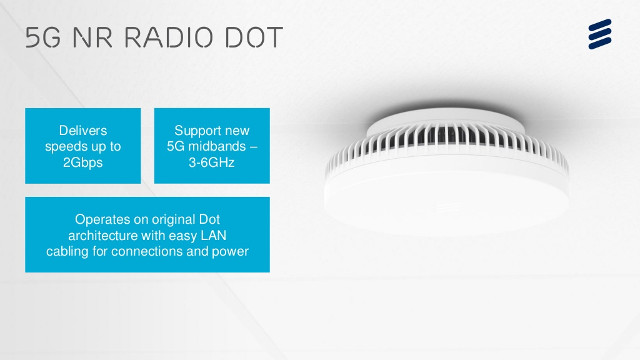5G cellular technology is coming sometimes in 2019, before ramping up in 2020 in several countries. The new 3GPP standard will allow maximum bandwidth up to 10 Gigabit per second, and we’ve already seen announcements such as Snapdragon X50 5G Modem which will be able to reach up to 5 Gbps download speeds.
5G apparently works at either high bands starting at 28 GHz and up to 60 GHz, which means 5G signal might have a really hard time penetrating through walls or other obstacles, or at mid bands between 3.5 and 5 GHz which will still be a challenge compared to 4G LTE operating between 600 MHz and 3.5 GHz.
 That means that signal from outdoor base station won’t be able to penetrate in all building, so 5G indoor small cells will be necessary for good indoor coverage. Ericsson has already unveiled their own small cells with 5G radio dot supporting 5G midbands and delivering up to 2 Gbps with the cells connecting to the local network (Ethernet) within the building. It’s also possible to combine up to 8 5G radio dots together to achieve higher overall speeds, and the 5G radio dots are said to be an easy upgrade from 4G Radio dots.
That means that signal from outdoor base station won’t be able to penetrate in all building, so 5G indoor small cells will be necessary for good indoor coverage. Ericsson has already unveiled their own small cells with 5G radio dot supporting 5G midbands and delivering up to 2 Gbps with the cells connecting to the local network (Ethernet) within the building. It’s also possible to combine up to 8 5G radio dots together to achieve higher overall speeds, and the 5G radio dots are said to be an easy upgrade from 4G Radio dots.
5G Radio Dots are still in development, testing with customers will start by the end of the year, and become available in 2019. Based on the video in the product page (and embedded below), the solution will be available globally, but China may be one of the first country with an implementation. The company will be add Mobile World Congress 2018 on February 28 – March 1 to discuss with operators about their latest 5G solutions.
Thanks to TLS for the tip.

Jean-Luc started CNX Software in 2010 as a part-time endeavor, before quitting his job as a software engineering manager, and starting to write daily news, and reviews full time later in 2011.
Support CNX Software! Donate via cryptocurrencies, become a Patron on Patreon, or purchase goods on Amazon or Aliexpress





